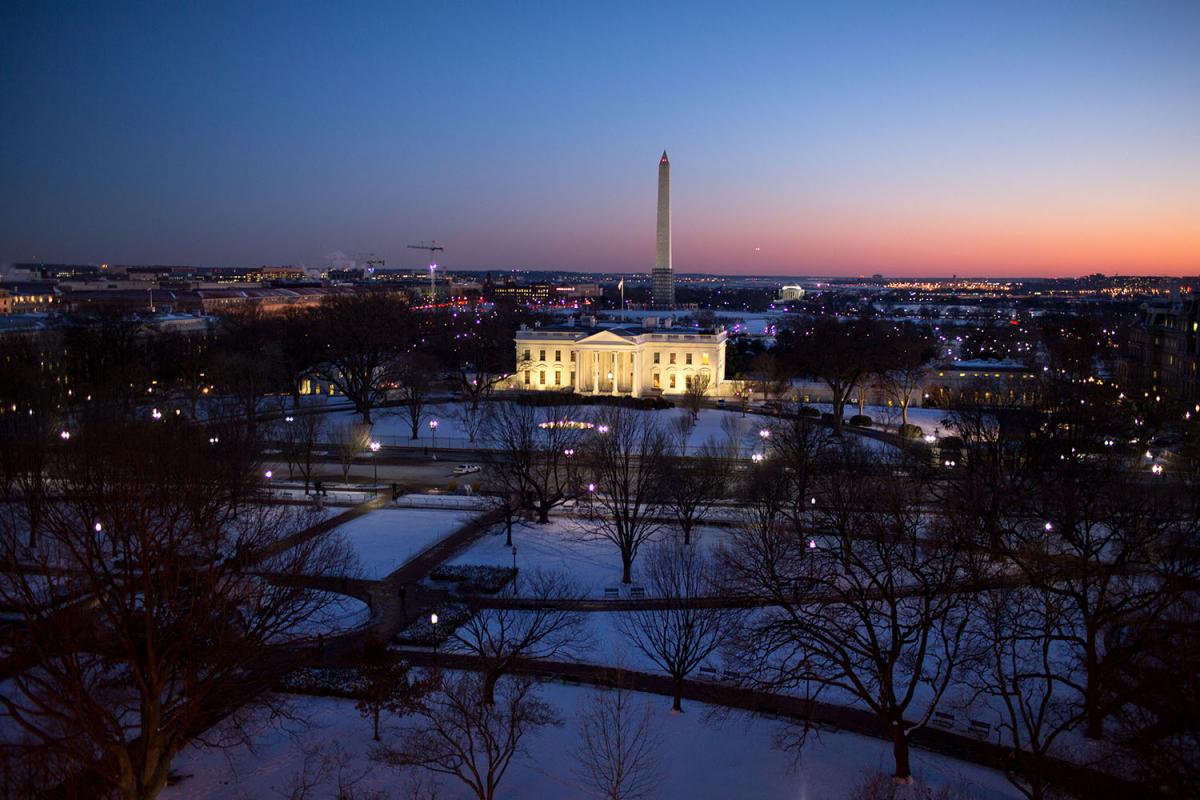A Deeper Dive into Confidence in the President and the Military on National Security Matters
Last Thursday, we released the latest data in our ongoing project measuring public confidence in major American institutions on national security matters. In this post, we do a deeper dive on a specific area of our latest findings: the public’s confidence in the President and the military both in general and in their handling of specific national security matters more particularly. The data offer some striking insights about the public’s attitude toward each institution.

Published by The Lawfare Institute
in Cooperation With

Last Thursday, we released the latest data in our ongoing project measuring public confidence in major American institutions on national security matters. In this post, we do a deeper dive on a specific area of our latest findings: the public’s confidence in the President and the military both in general and in their handling of specific national security matters more particularly. The data offer some striking insights about the public’s attitude toward each institution.
The bottom line is that confidence in the President as a general actor on national security matters is low and that the public has exceptionally low confidence in his handling of specific matters. By contrast, the military is admired and people have high confidence in it as a general matter; at the same time, confidence in ongoing military operations is not strong. The people trust the military, but it doesn’t have confidence in what it’s doing right now.
As always in this project, we collected these data using Google Surveys, which has supported this project with an in-kind donation of access to its survey platform. Respondents are Internet users over 18 who answer “surveywall” questions on websites that use the Google Opinion Rewards app, including a network of more than 1,500 sites such as the Financial Times and USA Today. For more information on Google Surveys’ methodology, including questions about sampling bias and inferred demographics, see Google’s white paper on the subject.
Confidence Generally in the President to Protect National Security


In October, as we reported last week, overall confidence in the President to protect national security fell marginally from September. 41.6 percent of respondents said they have no confidence (1 on a scale of 5) in the President to protect U.S. national security, an increase of 0.7 percent over September, with another 11 percent selecting “2,” the next lowest score. Respondents selecting “5” (high confidence”) comprised 23 percent of the sample, a decrease of more than 2 percent from September, with some from this group in September appearing to shift in October to the next highest score, 4, resulting in an increase of 0.3 percent in that category.
Nationally, 28 percent of men expressed high confidence “5” in the President’s ability to protect U.S. national security, a decrease of 5 percent from September. Among women, 18 percent of respondents said they had high confidence “5” in the President, an increase of about half a percent from September. Among respondents aged 18-34, a combined 59 percent selected “1” and “2,” whereas only a combined 26 percent selected “4” and “5.” Among Americans aged 55 and older, only 42 percent of respondents rated the President “4” and “5,” whereas 48 percent selected “1” and “2.”
It’s not at all clear that this the apparent movement constitutes more than statistical noise. The average presidential confidence is still marginally higher than in was in July, when we first asked this question. So it’s perfectly possible that there is no downward trend here, just natural fluctuation. If confidence in the President is trending downward, moreover, a number of different variables may be contributing to the decline: his heated war of words with North Korea and his decision to decertify Iran’s compliance with the Iran deal, for example—as well as a broader mistrust of a president who behaves erratically. The ongoing investigation into the Trump campaign’s contacts with Russia could also be playing a role
The problem for President Trump is that these numbers get notably worse the moment the question focuses on specific national security matters, rather than national security as a general subject.
Confidence in the Military to Protect U.S. National Security
In October, we began asking respondents how much confidence they have in the military to protect U.S. national security. In contrast to the President, the military enjoys very high confidence numbers from the public on its ability to protect national security as a general matter—significantly higher than does any other institution we have asked about.
Overall, a combined 64 percent of respondents gave the military higher confidence ratings, with only a combined 15 percent of respondents signaling low or no confidence. These numbers differed a bit among respondents aged 18 to 34, with only a combined 57 percent using the higher confidence ratings, and slightly more than with older respondents, a combined 20 percent, signaling lower confidence. But the military polls well with all demographic subgroups. The overall takeaway is that the military remains, in overwhelming terms, a trusted institution.


But as with the President, public confidence drops significantly when the questions turn to specific national security problems.
Confidence in the President to Handle Terrorist Threats
The question on which Trump fares best is terrorism, but even here, the low confidence numbers are higher than on the general question. A majority of Americans—54 percent—express lower confidence in the President’s handling of terrorist threats. This is marginally higher than the 53 percent who express low or no confidence in him on national security matters generally. But it is notable given that President Trump ran on strong counterterrorist rhetoric and criticized his predecessor’s handling of terrorism issues.


The spread between male and female respondents here is sizable, with men across all regions and ages signaling far more confidence in the President to handle terrorist threats than women. For example, 26 percent of all male respondents scored “5,” the highest, and 37 percent gave the President “1,” the lowest. By contrast, only 17 percent of women selected “5” and 49 percent of women gave Trumpa “1” on terrorism. This is a gap of nearly 10 percentage points by gender on each extreme end of the spectrum.
Confidence in the President to Handle Iran
This picture gets worse for the President when respondents are asked about Iran. The President’s decision in October to decertify Iran’s compliance with the nuclear deal was a major news item. In his administration’s public messaging, the President has attempted to make a case that Iran’s fundamentalist regime and its support of terrorist proxies in the Middle East warrant a tough U.S. response, including a reevaluation of the Iran deal. Our data suggest he has not persuaded Americans that he has defined a strategy to handle Iran effectively.


A striking 57 percent of respondents signaled low confidence in the President to handle Iran, whereas only 28 percent signaled high confidence. No particular subgroup offers strong support for the President’s handling of Iran. For example, 51 percent of male respondents aged 55 and older gave the President lower confidence numbers, and only 39 percent gave the President higher confidence rankings. Young respondents aged 18 to 34 of both genders were likewise very down on the President, with a combined total of 59 percent of that group giving the President lower confidence ratings.
There were, however, regional differences. For example, respondents in the West were less confident in the President than were those in the South.
Confidence in the South in the President’s Handling of Iran


Confidence in the West in the President’s Handling of Iran


In the West, ten percent more respondents said they had “no confidence” in the President’s handling of Iran than in the South. Furthermore, 22 percent of respondents in the South gave the President higher confidence ratings, whereas only 17 percent of respondents in the West did the same. This kind of contrast between respondents in the South and other geographic regions is observable in other national security matters, reflecting overall higher confidence in the President from respondents in the South.
Confidence in the President’s Handling of North Korea
Worse still, if only marginally, is public confidence in the President’s handling of North Korean.


A combined 58 percent of respondents gave the President lower confidence measures in his handling of North Korea. Across geographic areas, there are some interesting variances. For example, in the West, a combined 68 percent of respondents gave the President lower confidence numbers, roughly 10 percentage points higher than the national average. This may be a function of the West Coast’s geographic proximity and exposure to a North Korean missile strike should tensions continue to escalate.
Respondents aged 18 to 34 also gave the President lower confidence measures than did the public at large, with 66 percent of respondents giving him low confidence ratings. But even older Americans, those aged 55 and older, assessed the President’s handling of North Korea poorly, with a combined total of 53 percent giving him lower confidence numbers; these are better than Trump did with younger voters but still majority negative. Only among men in this age subgroup did the President fare notably better: a combined total of 43 percent of older men gave him higher confidence ratings.
Confidence in Ongoing U.S. Military Operations in Iraq and Syria
As with the President, the overall level of confidence in the military generally is higher than confidence in the military’s handling of specific items on its agenda. The public may have great confidence in the military in general, but pluralities give low confidence ratings to ongoing military operations both in Syria and Iraq and in Afghanistan.


U.S. military operations in Iraq and Syria produced the most ambivalent response. The modal response on this question was “3.” However, far more respondents (44 percent) selected either “1” or “2,” than selected “4” or “5” (28 percent). While the numbers are somewhat worse among younger respondents, the broad pattern is the same at any age. No group showed a plurality with that gave higher confidence numbers to current U.S. military operations in Iraq and Syria.
Confidence in Ongoing U.S. Military Operations in Afghanistan
The same pattern is visible, though slightly less acute, with respect to ongoing military operations in Afghanistan.


The modal respondent, at 28 percent, gives the military a “3” rating, whereas a combined 40 percent of respondents signal lower confidence ratings. Breaking it down by age, young respondents aged 18-34 are far more pessimistic about ongoing U.S. military operations in Afghanistan than is the population at large:

 Given the ongoing nature of these conflicts and international challenges, we look forward to seeing how the data on these issues evolve. The conflict in Afghanistan has been running seventeen years. The tension over North Korea’s attempts to threaten the US with nuclear weapons has been running more than twenty years. US military action in the Middle East has been controversial since the Iraq War began in 2003. We hope that regular questions about these issues will develop more regular insights into the American people’s support (or lack thereof) for the US government’s approach to each.
Given the ongoing nature of these conflicts and international challenges, we look forward to seeing how the data on these issues evolve. The conflict in Afghanistan has been running seventeen years. The tension over North Korea’s attempts to threaten the US with nuclear weapons has been running more than twenty years. US military action in the Middle East has been controversial since the Iraq War began in 2003. We hope that regular questions about these issues will develop more regular insights into the American people’s support (or lack thereof) for the US government’s approach to each.






.jpg?sfvrsn=cb803a66_6)

